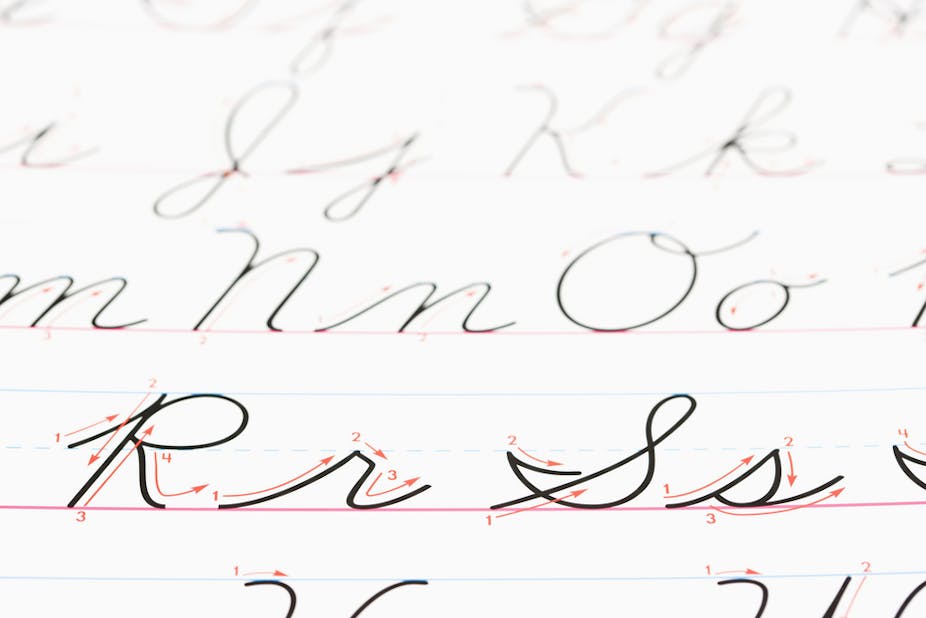Many lament that the “good old days” when they were taught “the basics” at school have gone. When launching the National Curriculum in 2010, then-prime minister Kevin Rudd stated his objective was:
… without apology, to get back to the absolute basics on spelling, on sounding out letters, on counting, on adding up, on taking away. The basics that I was taught when I was at primary school a long time ago, and that’s what our national curriculum is all about.
Many would include the teaching of handwriting on this list of “basics”.
In the meantime, we have moved into the 21st century with new technologies permeating every aspect of our lives. No-one would think to ask the textile industry to go back to using the “Spinning Jenny”, an antiquated machine that enabled the production of textiles, or decree that a laundry go back to washing clothes by hand. But they think it’s okay to ask teachers to concentrate on industrial revolution “basics”.

There are obviously foundational skills and concepts that we all need to acquire. This includes knowing how our language works and the conventions of grammar and spelling, since these enable us to communicate more effectively.
But what of concerns about the poor handwriting skills of 21st-century students? English teacher Christopher Bantick, a self-confessed Luddite, wants computers and typing to be subjected to tests that will show that they improve learning – yet not the same for the pencil. He states:
I have just completed marking end-of-term secondary school exam papers. All were hand-written. The writing was somewhere between reasonable to poor. The reason? A lack of practice. Exams and handwritten answers are here to stay across Australia for the immediate future.
Why do students have to write answers with pens in exams? They are much faster at typing, so why are they not allowed to use their laptops in their final exams?
Most recently, the media reported a research project as having found that students who took notes by hand had better learning outcomes than those who took notes on a laptop. But when you actually go to the source of the study, the results indicate that learning outcomes were related to answering two different types of questions.
There were no differences in responses to factual questions (for example, “how long ago did the Inca civilisation exist?”) between the two groups, but the handwritten note group did perform better on conceptual tasks (“In what ways do the Incas differ from the Mayans?”). The differences in performance were attributed to the type of notes taken.
Those typing took longer verbatim notes because they were fast and had time. Handwritten notes required more conceptual thinking because of the slowness of the process – the students had to be more selective in what they could write. You might think that the more detailed typewritten notes would enable the students to draw on more information to answer conceptual questions more effectively – but this did not happen. The study did not extend to discover why this might have occurred.
But short-term instruction on note-taking did not improve the performance of answering the conceptual questions for the typing group. Thus, it was the type of notes taken, not the medium, that was relevant. It leads us to think that effective instruction on note-taking and assessments that require short answers might have the potential to benefit typing computer users.
Criticisms of student handwriting centre on a perceived lack of ability to write legible cursive in test situations, as well as in everyday life. Yet when was the last time you wrote in cursive? While there is recognition that using a pencil or pen is a useful skill to have, spending school time on learning cursive, via careful copying of the letters and patterns, does not seem a particularly good use of school time.
Professor Amy Bastian from John Hopkins University, a motor neuroscientist, notes:
The more variety of things you do in the fine motor domain, the more variety of hand movements you make, will improve your dexterity.
But Bastian does not distinguish between writing in cursive or printing. Steve Graham, an education researcher from Arizona State University, takes it one step further and declares:
It really doesn’t matter if it’s manuscript or cursive.
So this is what it comes down to – a lack of practice, as Bantick stated. But not practice in using a pen or pencil. Some reports say students are not writing much in schools at all. They are filling in blanks on worksheets, one-sentence responses to set questions and only sometimes some short pieces summarising information.
21st-century learners need to have opportunities to write – to create narratives, with pens, pencils and keyboard. Not only will this give them the best chance of learning in different formats, it will enable them to become fluent in both. What they don’t need is endless cursive practice on mindless sheets and being required to write in this mode for exams.
Further reading:

